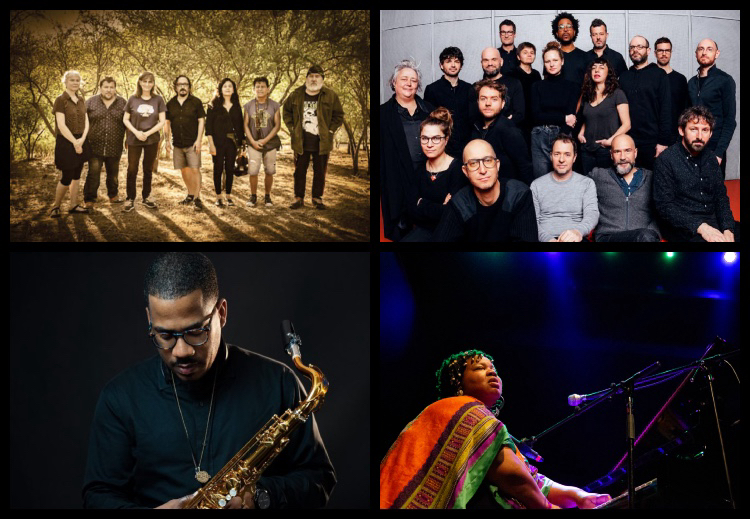PostGenre’s Best of 2023
|
Getting your Trinity Audio player ready...
|
Below are the albums we collectively felt were the best of 2023 (technically from Thanksgiving 2022 to Thanksgiving 2023). Ties are ordered alphabetically by the leader’s last name. Following the list are honorable mentions; recordings multiple members of our small group thought worthy of merit but did not make the top ten. One trend that frequently recurs throughout the list is a focus on the interplay between tradition and modernity, whether turning old gospel tunes into avant-garde open experiments or seeing what spectralism and artificial intelligence can mean in the context of the longstanding large ensemble format. We are excited to have friend and esteemed journalist Jim Hynes join us in presenting this list as well as having Anthony Dean-Harris return for it. — Rob Shepherd
10. Lakecia Benjamin – Phoenix (Whirlwind)
“As difficult a challenge it is for rising saxophonist/bandleader Lakecia Benjamin to match the brilliance of her tribute to John and Alice Coltrane, Pursuance: The Coltranes, Benjamin succeeds in a similar way, relying on highly recognizable guests… Phoenix, Benjamin’s fourth release, is arguably as massive in scope with a theme of female empowerment, delivered through her spiritual saxophone playing, smartly placed spoken word segments and key vocal tracks... Benjamin (alto saxophone, synths, vocals, sound design) fronts a completely new core band comprised of trumpeter Josh Evans, Victor Gould on keys, Orange Rodriguez on synths, drummer Enoch (EJ) Strickland, percussionist Nêgah Santos, and bassist Ivan Taylor. Trumpeter Wallace Roney Jr., Rhodes organist Anastassiya Petrova, and bassist Jahmal Nichols all join for one track each. Yet, the focus, in addition to Muldrow, rests on guests Dianne Reeves, Patrice Rushen, Sonia Sanchez, Angela Davis, and Wayne Shorter. Benjamin cites these individuals as having a profound influence on her and she developed the compositions they deliver with their specific skillset in mind… With her Coltrane tribute, we were impressed by Benjamin’s ability to channel that music beautifully and more than hold her own amidst the gathered jazz royalty. Here, she is even more clearly the star, and aside from a few minor sound effects missteps, the album stands just as tall because this is definitively Benjamin’s saxophone voice and her own personal statement.” — Jim Hynes, excerpted from Glide Magazine
7 (tie). Susan Alcorn – Canto (Relative Pitch)
Canto finds pedal steel maestro Susan Alcorn leading several Chilean musicians – Luis “ToTo” Alvarez, Claudio “Pajaro” Araya, Francisco “Pancho” Araya, Rodrigo Bobadilla, Amanda Irarrazabal, and Danka Villanueva – across a series of original compositions and a Victor Jara cover. All was recorded in a remote studio in Chile.
Alcorn herself believes this work is not jazz. That perspective seems to make sense as at its core lies Chilean nueva canción, a folk form that played a profound role in the pro-democracy social upheavals in that country during the military dictatorship of Augusto Pinochet. As such, the sound of Canto comes more from singer-songwriter music from Latin America than the Black American lineage that guides jazz.
But what is jazz if not a continued artistic search for freedom? In this sense, Canto’s nueva canción roots grow from a similar ground as jazz. Both provide a voice to the oppressed seeking a better life. Both forms highlight the artistic excellence that can emerge from dire circumstances. And both prevail through hardship. Perhaps most importantly, Canto actually sounds like a melding of jazz and Chilean folk music. There are also occasional flourishes of contemporary classical with emerging hues of Messiaen and Morricone, among others. Further, on a purely technical level, the album’s approach to nueva canción adopts Alcorn’s harmonic language, one rich in microtonality and dissonance, two aspects shared with both avant-garde jazz and New Music.
Canto is a gorgeous recording that is continually emotionally stirring. Its remorseful tunes hit your heart hard before leaving you with the hope of everyone someday having a “right to live in peace.”— Rob Shepherd
7 (tie). Art Ensemble of Chicago – From Paris to Paris: The Sixth Decade (Rogue Art)
“Once branded musical insurrectionists when they burst on the scene in the late sixties, the two surviving members of the Art Ensemble of Chicago (AEC) original quintet, deliver an all-encompassing resurrectionist statement by expanding to a chamber orchestra on this live 2-CD recording, The Sixth Decade, From Paris to Paris. The album was recorded in France in 2020 at the Son d’hiver festival, coming full circle to where the group was first formed in 1968. The two founding members, saxophonist/composer Roscoe Mitchell (sopranino and alto) and drummer/percussionist Famoudou Don Moye not only expanded the band but have reshaped its sound, primarily through the addition of arguably today’s most dramatic spoken word artist, Moor Mother. In addition, in-demand avant-garde cellist Tomeka Reid and violinist Jean Cook join together with semi-regulars – trumpeter Hugh Ragin, flutist Nicole Mitchell, and bassist Jaribu Shahid. Those players are essentially the core unit but in keeping with the philosophy of the AACM (Association for the Advancement of Creative Musicians), Mitchell and Moye invite a diverse group to expand the unit to seventeen members… [The Art Ensemble has] always boasted temerity for uncharted waters. Set in Paris, we have the confluence of American and European musical forms from string quartets to art songs, to chorales, spoken word declarations, and even touches of opera. Mixed in, you’ll still hear the Mitchells (no relation) squawks and birdcalls, and from the group at large boundaryless free jazz, African percussion, and full-fledged exploration. Reid says no two shows are ever the same, owing to the leader, 82-year Roscoe Mitchell’s improvisational nature… Rarely, if ever will you find a performance with so many colors, tones, textures, and rhythms that range from easily accessible to anything but.” — Jim Hynes, excerpted from Glide Magazine
7 (tie). Brandee Younger – Brand New Life (Impulse!)
It’s not hard to say that harpist Brandee Younger has cornered the market on jazz harpists in our current era, mastering her instrument with soul and a distinct personality borne as much of the moment as in the history of the instrument and the genre. Thus, her giving credence to Dorothy Ashby’s work of the 1970s is entirely befitting, recontextualizing Ashby’s compositions, proving them to be as timeless as Younger’s own work in the same continuum. — Anthony Dean-Harris
6. Daniel Villarreal, Jeff Parker, Anna Butterss – Lados B (International Anthem)
Lados B is a simple trio album– drums, guitar, bass. It’s a collection of sketches as much as it is a collection of complete songs. It’s an album that celebrates the groove as much as it celebrates the ideas that created it. They’re expressions of the moment, the very definition of jazz, and the clearest statement that didn’t mean to be a statement I’ve heard all year.— Anthony Dean-Harris
5. Darius Jones – fLuXkit Vancouver (i̶t̶s̶ suite but sacred) (Northern Spy/WeJazz)
An innovation of the 1960s-era Fluxus art movement, the fluxkit was a small container that held an assortment of objects in various media, serving as a small, portable museum. Apparently, the physical edition of fLuXkit Vancouver (i̶t̶s̶ suite but sacred) by saxophonist Darius Jones extended the trope by being presented as a sort of fluxkit itself. But those listeners who encounter the release in digital form, as this writer did, would experience an assortment of musical “objects” that delight, provoke (something the original Fluxians might have applauded), and ultimately amaze.
While the original fluxkits were more or less random assemblages, Jones’ four-movement, 52-minute work is a rigorously plotted composition that strikes the ear with the explosive vigor of a free-jazz freakout. Credit Jones’ blues-soaked, room-filling alto saxophone played with the fervency of a storefront preacher. He is joined by a string quartet of violinists Jesse and Josh Zubot, bassist James Meger, and cellist Peggy Lee, the latter’s presence a signal that this is not a classical vs. jazz mismatch. One of the great, if rather unheralded (at least south of the 49th parallel) improvisors, Lee calls on a remarkable range of musical strategies in both solo and ensemble settings. But so too do her ensemble colleagues from Vancouver, where this was recorded at the historic Western Front, a space for interdisciplinary art and music with strong ties to the Fluxus movement. The secret sauce here is Gerald Cleaver, who orchestrates the music from the drum kit, adding color and propulsion when called for and supplying a lively and thought-provoking through line.
There is no shortage of recordings of improvising soloists in the Black American tradition with string quartets, but fLuXkit Vancouver brings the two traditions together in a way that feels new and vital, like a Fluxus movement in music. — John Chacona
You can read Rob Shepherd’s interview with Darius Jones on this project here.
4. Kris Davis – Diatom Ribbons Live at the Village Vanguard (Pyroclastic)
Imagine a hypothetical AI tool that could create music the way ChatGPT generates words. Now imagine feeding it this prompt:
Create an album of music that incorporates elements of the jazz vocabulary most prominently but also references other current trends and vectors. The music should be brainy but viscerally compelling and include one or two covers by prominent jazz composers (Wayne Shorter is a good reference point), should use acoustic and electronic sources, have strong melodies but also adventurous, boundary-pushing excursions, a powerful rhythmic foundation, and compelling soloing and be performed in an effortlessly virtuosic manner by an ensemble with an eye to gender equity. The result should be a distillation of the state of creative music in 2023 at its highest level.
Such a tool doesn’t yet exist —let’s hope—but if it did, it might return something like Diatom Ribbons Live At The Village Vanguard.
But this is no mere punch list of cleverly designed gambits; Kris Davis, whose Pyroclastic Records label released the two-part set, is far too curious and questing an artist to have a formula in mind. Instead, we get an almost two-hour-long survey of compositional and improvisatory strategies. Past masters are honored with covers of music by Shorter, yes (two versions of “Dolores”), but also Ronald Shannon Jackson (the rolling “Alice In the Congo), and the increasingly essential Geri Allen (“The Dancer” at a tempo that somehow maintains an exquisite yet provisional balance). By incorporating the voices of Sun Ra and fellow Canadian pianist Paul Bley, both reflecting on the brilliance of Charlie Parker, Davis places them—and herself—at the center of a dynamic, evolving tradition. And yet, despite the star power of the band, drummer Terri Lyne Carrington, bassist Trevor Dunn, Val Jeanty on turntables with newcomer Julian Lage, and the volume of material, there’s nothing show-offy about the album (how very Canadian!).
With Diatom Ribbons Live At The Village Vanguard, we get an integrated, comprehensive, and coherent statement from five of our most valuable musicians that takes stock of where we are today and points to where we might be headed. It’s a musical future we should all look forward to.— John Chacona
You can read Brian Kiwanuka’s review of this album here and Rob Shepherd’s interview with Kris Davis on it here.
3. Steve Lehman and Orcheste National De Jazz – Ex Machina (Pi)
A misguided music journalist friend recently stated that he did not appreciate avant-garde music because it “only deconstructs existing standards; it never creates something.” On its face, this claim is laughably inaccurate. But it’s hard to find an album that better disproves his commentary than Ex Machina.
Building upon George Lewis’ Computer Music and various electro-acoustic projects, Lehman uses IRCAM-crafted artificial intelligence to reach new realms. Where many see AI as a conceptual boogeyman, Lehman sees the tool’s potential. He then adds in his long-established interest in spectral harmony. Along the way, he finds a kindred spirit in Frédéric Maurin and the Orchestre National de Jazz. Together, they turn the longstanding big band format on its head and give it renewed vigor. By reaching out – to newer technologies, more novel methods of composition, and freer solos- the group builds something wholly new. Lehman has yet to produce an album that is not essential listening. But even among that lofty crop, Ex Machina seems to rise to the top. — Rob Shepherd
Check out Rob Shepherd’s interview with Steve Lehman on this project here.
1 (tie). James Brandon Lewis and Red Lily Quintet – For Mahalia, With Love (TAO Forms)
The follow-up to Jesup Wagon (Tao Forms, 2021) moves from the legacy of George Washington Carver to shine a light on one of the greatest vocalists to ever live. Many would refer to For Mahalia, With Love as a tribute album, but the recording is far more than a work honoring its stated subject.
Structured as a three-way conversation between Lewis, his grandmother, and the gospel legend herself, the work does not merely cover the songs that endeared Jackson to so many. Instead, Lewis examines how her music fits into his creative DNA. As a result, his original composition “Sparrow” slips effortlessly into the old “His Eye is On the Sparrow” as if the two were destined for unity. “Swing Low” is turned into a reflection of both the significance the singer had on the Civil Rights Movement and the fortitude Lewis’ grandmother, and countless others, had to live through the era. It’s a beautiful recording from an artist who continually pushes the music forward yet does so with reverence for his forebears. The top-notch personnel of Chad Taylor, Kirk Knuffke, Chris Hoffman, and living legend William Parker also certainly helps. — Rob Shepherd
Read Rob Shepherd’s interview with James Brandon Lewis on this project here.
1 (tie). Todd Sickafoose – Bear Proof (Secret Hatch)
Concept albums have an uneven history in jazz. Not all subjects map gracefully onto a jazz template, and a desire to explain or illustrate can rob the music of its vitality. All too often, inspiration runs out before the double bar, and large amounts of filler are needed to fill the gaps between good ideas. Any one of those traps might have snared Todd Sickafoose, but Bear Proof, released on his own Secret Hatch Records label, is everything a concept album should be: thought-provoking, generous, and deeply felt.
Sickafoose’s concept couldn’t be more urgent: a meditation on the whipsaw cycles of boom and bust that increasingly seem emblematic of the winner-take-all nature of financialized late capitalism. As a native San Franciscan, Sickafoose knows this territory well, but it’s not the sort of thing that makes you want to burst into song. Yet somehow, the bassist conveys the human and natural drama at the heart of his thesis, and he does it in music with the grand sweep of Dos Passos’ U.S.A. Trilogy and much of its sorrow, too.
You hear it in the choked, anguished high-register cries of Kirk Knuffke’s cornet and the lonely twang of Adam Levy’s Telecaster, wandering through reverb-drenched abandoned spaces and despoiled vistas. On violin and clarinet, respectively, Jenny Scheinman and Ben Goldberg can be acidulous at one moment and consoling the next. Pianist Erik Deutsch and Rob Reich on accordion lay down a bed of spare but cinematic harmony, much of it in the big-country vein of Aaron Copland’s Americana music, as Allison Miller lays down grooves with the confidence and pinpoint accuracy of a session drummer—a high compliment indeed.
Sickafoose has substantial experience as a producer and sideman with rock and pop acts, and Bear Proof has the polish and attention to detail of a big-budget pop record. And yet, incredibly, it was recorded in a single 62-minute take live in the studio. Even more remarkable is the consistent aquifer of gorgeous, memorable melody that flows unbroken from beginning to end and glows with commitment.
Sickafoose’s Tiny Resistors (2008), a session that shares much of Bear Proof’s personnel, was among the last releases of violinist Jeff Gautier’s L.A.-based Cryptogramophone Records, a label distinguished by the meticulous care given to every detail of every release, from production to recording quality to graphics. Bear Proof is a distinguished successor in that lineage. It’s not just a great jazz concept album but a great jazz album on any terms.— John Chacona
Honorable Mentions- The following are albums on the lists (10 choices) or extended lists (more than 10) of two or more writers, sorted alphabetically by the artist’s last name. It seemed these recordings were worth honoring as well:
Darcy James Argue’s Secret Society – Dynamic Maximum Tension (Nonesuch)
Tomas Fujiwara- Pith (Out of Your Head)
Miho Hazama M Unit – Beyond Orbits (Edition)
Ingrid Laubrock – Last Quiet Place (Pyroclastic) – You can check out Rob Shepherd’s interview with Laubrock on this album here.
Cecile McLorin Salvant – Melusine (Nonesuch)
Henry Threadgill – The Other One (Pi)



